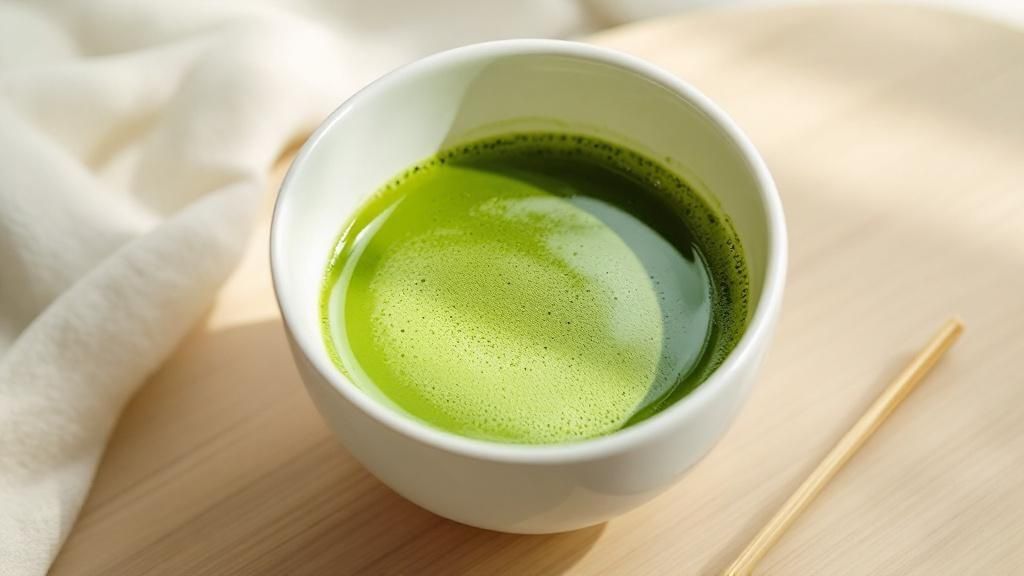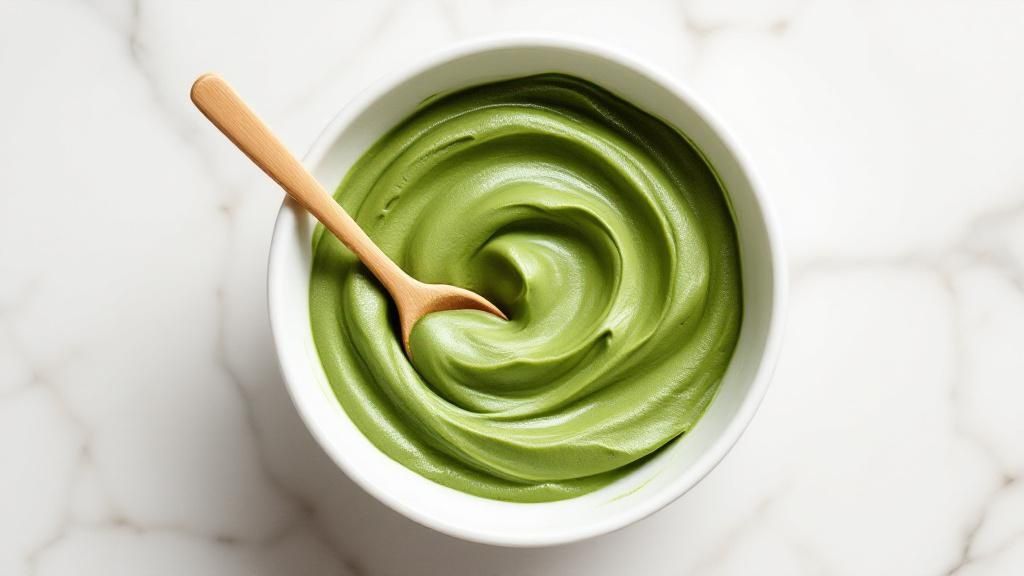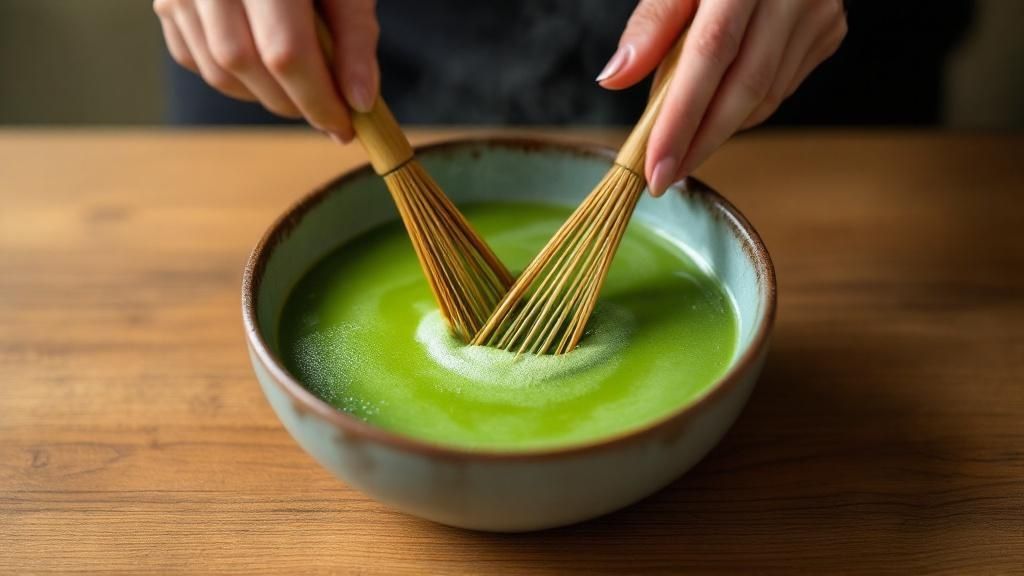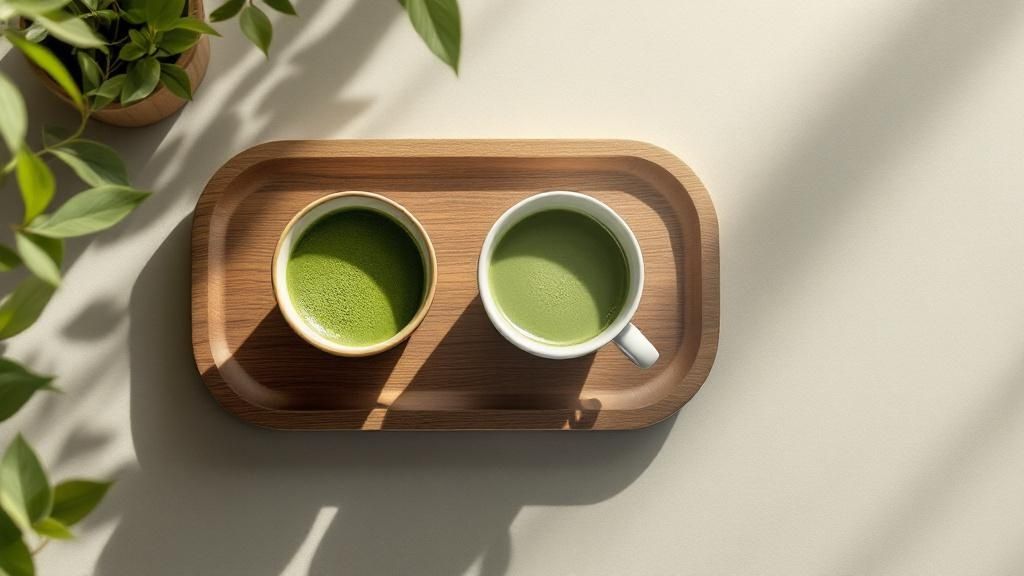Diving into the world of matcha can feel a bit like learning about wine. You hear terms like ‘ceremonial’ and ‘culinary’, but what do they actually mean? It's not as complicated as it sounds, I promise. The different types of matcha tea essentially boil down to three main grades: Ceremonial, Premium (often called Latte grade), and Culinary.
The key difference lies in which leaves are picked, when they're harvested, and how they're processed. Each grade has its own unique flavour profile and a job it’s best suited for.
Your Introduction to the World of Matcha

So, what is matcha? It's not just another green tea. It's a vibrant, finely milled powder made from specially grown and carefully processed tea leaves. Understanding the grading system is your ticket to getting the most out of every spoonful.
I like to think of it like olive oil. You have that really special, cold-pressed extra virgin olive oil you’d only use for drizzling over a salad or dipping bread into. Then you have your everyday olive oil for cooking. Matcha works in a similar way. The highest quality is reserved for sipping and savouring in traditional tea ceremonies, while other grades are perfect for your daily latte or a bit of kitchen creativity.
Why Matcha Grades Matter
Getting to grips with the grades means you can pick the right powder for the job, every time. It saves you from wasting a beautiful, delicate ceremonial matcha in a cake where its subtle notes would be lost, and from trying to whisk up a bitter, culinary-grade powder for a traditional tea.
Here's a quick rundown of what sets them apart:
- Ceremonial Grade: This is the best of the best. It's made from the youngest, most tender leaves from the very first harvest of the year. It’s meant to be prepared simply—just whisked with hot water—to let its naturally sweet, smooth, and umami-rich flavour shine. There should be absolutely no bitterness here.
- Premium & Latte Grade: This is your perfect daily driver. A small step down from ceremonial, it has a more robust flavour that’s strong enough to hold its own against milk and sweeteners, making it ideal for lattes, cappuccinos, and other mixed drinks.
- Culinary Grade: Made from leaves harvested later in the season, this grade has a much stronger, more astringent profile. That bold flavour is exactly what you want when baking or blending it into smoothies, as it ensures the distinct matcha taste isn't lost among other ingredients.
Matcha is more than just a beverage; it's an experience rooted in tradition and craftsmanship. Each grade offers a unique window into this rich culture, from the meditative calm of a ceremonial bowl to the creative joy of a matcha-infused dessert.
And it’s clear people are catching on. The UK matcha tea market is set to explode, projected to more than double from USD 340 million in 2025 to nearly USD 790 million by 2031. This surge is all thanks to a growing desire for antioxidant-rich, plant-based drinks. While matcha is its own unique thing, you might also find it interesting to explore our broader guide on the different https://www.jeevesandjericho.com/blogs/news/types-of-tea.
Matcha Grades at a Glance
To make it even easier to choose the right matcha for you, here’s a simple table breaking down the key differences.
| Grade | Colour | Flavour Profile | Primary Use |
|---|---|---|---|
| Ceremonial | Vibrant, emerald green | Smooth, delicate, sweet, rich umami | Traditional tea ceremony (whisked with water) |
| Premium/Latte | Bright green | Bold, slightly sweet, robust | Lattes, smoothies, iced teas |
| Culinary | Duller, yellowish-green | Strong, astringent, slightly bitter | Baking, cooking, sauces |
This quick guide should help you navigate the shelf with confidence, whether you're after a moment of quiet contemplation or a burst of green goodness in your next bake.
Understanding Ceremonial Grade Matcha

When we talk about Ceremonial Grade, we're talking about the absolute pinnacle of matcha. This is the highest quality you can find, and it's an experience all on its own. Think of it like a vintage champagne or a single-origin dark chocolate—it’s meant to be sipped and savoured in its purest form, not masked by other flavours.
This exceptional quality is born in the fields, long before the tea leaves are ever picked. The plants are carefully shade-grown for up to 20 days, a crucial step that starves them of direct sunlight. This forces the plant to go into overdrive, producing a huge amount of chlorophyll and the amino acid L-theanine. The result is that iconic, vibrant green colour and a complex, deeply savoury flavour known as umami.
For this grade, only the youngest, most tender leaves from the very top of the plant are hand-picked during the first harvest of the year, called ichibancha (literally "first tea"). These are the most nutrient-dense and flavourful leaves the plant will produce, and they form the foundation of this matcha’s incredible character.
From Leaf to Powder
Once harvested, the leaves go through a meticulous process. They’re briefly steamed to stop oxidation, which locks in their brilliant colour and precious nutrients. Next, the stems and veins are painstakingly removed, leaving behind only the pure, soft flesh of the leaf, known as tencha.
It's this tencha that is then slowly and patiently stone-ground into an impossibly fine, silky powder. Traditional granite stone mills grind the leaves at a very low temperature to avoid scorching them, which would ruin the delicate flavour. It can take a full hour just to grind 30-40 grams of matcha this way.
This careful, unhurried method produces a powder that's around 5-10 microns fine—about the same as talcum powder. This is why it dissolves so effortlessly into water, creating a smooth, creamy texture without a hint of grittiness.
The essence of Ceremonial Grade matcha lies in its simplicity. It's not an ingredient; it is the entire experience. Its delicate balance of natural sweetness and deep umami is designed to be appreciated on its own, offering a moment of calm and focus.
The True Flavour and How to Enjoy It
The flavour of a true ceremonial grade matcha is unmistakable. It’s naturally sweet with a rich, almost brothy umami depth and a smooth, lingering finish. Most importantly, it should have absolutely no bitterness or astringency. The aroma is fresh and vegetal, like walking through a field of spring greens.
Because its nuances are so delicate, this is a tea that deserves to be prepared in the traditional way.
- Preparation: Simply whisk it with hot water (around 80°C, never boiling) using a bamboo whisk, or chasen.
- Purpose: Best enjoyed on its own as usucha (thin tea) or the more intense koicha (thick tea) often served in Japanese tea ceremonies.
- Avoid: Please don’t mix it with milk or sweeteners! Doing so would completely overwhelm its subtle, complex character. That's a job for a different grade of matcha.
For Your Everyday Matcha: Latte Grade

Ceremonial matcha is for those quiet, thoughtful moments. But what about the matcha that fuels your busy morning? That’s where Latte Grade (sometimes called Premium Grade) comes into its own. It's the perfect middle ground, giving you the quality of early harvest leaves but with a bolder character designed for mixed drinks.
Think of it this way: if ceremonial is a rare vintage, latte grade is your fantastic, reliable table wine. It’s made for daily enjoyment, not just special occasions. This grade usually blends first and second harvest leaves, which gives it a more robust flavour profile that can stand up to milk and a bit of sweetness without getting lost.
You wouldn't add a shot of vintage champagne to a cocktail; its delicate notes would be totally swamped. It’s the same with matcha. Using a fine ceremonial grade in a latte is a waste of its subtlety. Latte Grade is specifically crafted to deliver that vibrant matcha punch, making it one of the most popular types of matcha tea for good reason.
The Perfect Balance For Your Daily Brew
The magic of Latte Grade lies in its balance. It has a stronger, more assertive green tea flavour than its ceremonial counterpart, with just a hint of pleasant bitterness that plays wonderfully with the creaminess of milk. That slight astringency is actually a plus here, as it cuts right through the richness of dairy or oat milk to let the matcha shine.
This grade is your go-to for all sorts of daily drinks:
- Matcha Lattes: Its bold profile makes sure the matcha flavour isn’t muted by steamed milk.
- Iced Matcha: It stands up to the dilution from ice, keeping your drink flavourful and refreshing.
- Smoothies: It blends beautifully with fruits and veggies, so you still get that distinct matcha taste.
The real beauty of Latte Grade is that it makes matcha accessible. It brings that vibrant green goodness into your daily routine, turning a simple latte into a nourishing ritual without the ceremonial price tag. It's the smart, delicious choice for your favourite drinks.
If you’re keen to master the perfect at-home latte, our specially formulated matcha latte blend is the ideal starting point. It’s designed to give you the best possible taste and texture when mixed. This is the matcha that empowers you to be your own barista, whipping up delicious green drinks that energise and delight, day in and day out.
Getting Creative with Culinary Matcha

If Ceremonial Grade is the champagne of the matcha world, think of Culinary Grade as the secret ingredient in your favourite cocktail—bold, versatile, and made to mix. It’s important to get one thing straight: ‘culinary’ refers to its purpose, not a dip in quality. This is the powerhouse of the different types of matcha tea, a real workhorse designed for the heat of the kitchen.
Culinary matcha comes from leaves picked later in the season. These more mature leaves have had more time in the sun, which gives them a much stronger, more astringent flavour and a less vibrant, slightly yellow-green hue. While that might not sound ideal for sipping straight, this boldness is exactly what makes it shine in recipes.
That punchy character is its greatest asset. It means the distinct matcha flavour can hold its own against other big hitters like flour, sugar, and butter. If you were to mix a delicate ceremonial powder into a cake batter, its subtle, grassy notes would just vanish. Culinary matcha, on the other hand, stands firm, making sure that classic, earthy green tea taste comes through loud and clear.
Putting Culinary Matcha to Work
The real joy of culinary grade is just how much you can do with it. It’s your ticket to a whole new world of flavour, well beyond the traditional teacup. Its strong profile makes it the smart, effective choice for all your kitchen experiments.
Here are a few ideas to get you started:
- Baking: It’s the magic touch for everything from matcha muffins and cookies to vivid green tea cheesecakes and swiss rolls.
- Smoothies: A spoonful gives your morning fruit or protein smoothie a fantastic flavour kick and a healthy dose of antioxidants.
- Desserts: Imagine matcha-infused ice cream, a silky panna cotta, or a dusting over tiramisu for a Japanese-inspired twist.
- Savoury Dishes: Don't just stick to sweets! Try it in salad dressings, marinades, or even as a seasoning for soba noodles.
Fancy a fun weekend project? Why not whip up a batch of delicious, fluffy pancakes? You can find some fantastic inspiration right here in our simple and delicious matcha pancake recipes.
Culinary Grade matcha is your invitation to get creative. It's the grade that says, 'go on, play with your food'. It’s affordable, packed with flavour, and designed to bring your culinary ideas to life.
The boom in using matcha in food is a huge part of its growing popularity. In the UK alone, the matcha tea market was valued at around USD 61.8 million and is on track to hit USD 98.3 million by 2030. Matcha powder is the clear favourite, making up over 55% of sales, which just goes to show how much we love using it in its most versatile form. You can read more about the UK's growing appetite for matcha with these matcha market insights from grandviewresearch.com.
How to Choose the Right Matcha for You
Walking into the world of matcha can feel a bit overwhelming at first. But figuring out which one to buy is actually quite simple once you know what you want to do with it.
It all boils down to one question: "How am I going to use this?" Your answer is the key that unlocks everything. It'll stop you from accidentally using a delicate, expensive ceremonial grade in a batch of brownies, or trying to whisk up a bitter culinary powder for a traditional tea ceremony.
-
For sipping straight: If you want to enjoy matcha in its purest form—just whisked with hot water—then Ceremonial Grade is the only way to go. Its subtle, sweet, umami-rich notes are designed to be enjoyed all on their own.
-
For daily lattes: Making a vibrant green latte, a refreshing iced tea, or a healthy smoothie? Latte Grade (sometimes called Premium) is your best bet. It has a stronger flavour that won't get lost when you add milk or other ingredients.
-
For the kitchen: If you're baking, cooking, or whipping up desserts, always reach for Culinary Grade. Its bold, slightly astringent taste is what you need to make sure that beautiful matcha flavour shines through flour, butter, and sugar.
Looking Beyond the Grade
Once you've picked a grade, there are a few other clues that signal a really high-quality powder. Think of them as the hallmarks of great matcha, no matter how you plan to use it.
The colour is a dead giveaway. Top-notch matcha should be a vibrant, almost electric, bright green. If it looks dull, yellowish, or brownish, that's a red flag—it likely means it’s old, was made from lower-quality leaves, or wasn't stored properly.
Choosing the right matcha isn't about finding the single 'best' one, but the best one for what you need right now. That top-tier ceremonial powder is perfect for a quiet morning ritual, but a punchy culinary grade is the hero your weekend baking project needs.
It's also worth checking where it comes from. While matcha is made in a few places now, Japan is its spiritual home. The Uji region, near Kyoto, has been the epicentre of high-quality matcha for over 800 years. An Uji matcha is usually a safe bet that you're getting something rooted in centuries of expertise.
Packaging and Freshness
Finally, don't overlook the packaging. Matcha's biggest enemies are light, air, and heat—they will quickly zap its colour, flavour, and health benefits.
Always choose matcha that comes in an opaque, airtight container. A small tin or a resealable foil pouch is ideal. Steer clear of clear glass jars or flimsy plastic bags. Freshness is everything, so once you've opened it, try to use it up within a couple of months for the best taste.
With these simple tips in mind, you'll be able to pick out a fantastic matcha every single time.
To make it even easier, here's a quick guide to help you choose the perfect matcha for any occasion.
Which Matcha Should You Buy?
A simple guide to help you choose the perfect matcha based on how you plan to use it.
| Your Goal | Recommended Matcha Grade | Why It Works Best |
|---|---|---|
| Enjoy a traditional, pure tea | Ceremonial Grade | Its delicate, nuanced flavour is meant to be savoured on its own. |
| Make a daily latte or smoothie | Latte or Premium Grade | Stronger flavour that holds its own against milk and other ingredients. |
| Bake cakes, cookies, or desserts | Culinary Grade | Bold and astringent, ensuring the matcha taste comes through in recipes. |
| Try a unique flavour profile | Single-Origin Matcha | Explore the distinct terroir and notes from a specific Japanese farm. |
Ultimately, the best matcha is the one that brings you the most joy, whether that's in a quiet cup of tea or a vibrant green cupcake. Happy whisking
Preparing and Enjoying Your Matcha
You’ve navigated the world of matcha and picked the perfect tin. Now for the best part – actually making it. Preparing matcha is a beautiful little ritual, and it’s far less intimidating than it looks.
Whether you’re after a traditional bowl of tea or a creamy, comforting latte, the key is to let the grade guide you. A delicate Ceremonial Grade asks for a quiet, classic approach, while a punchy Culinary Grade is ready for you to get creative in the kitchen.
The Traditional Whisk for Ceremonial Grade
To really get what Ceremonial Grade is all about, you have to try making it the traditional way. This method creates usucha (or thin tea), a smooth, frothy brew that lets all those subtle sweet and umami notes shine. It’s a mindful process that’s just as satisfying as the first sip.
- Sift Your Matcha: First, use a fine-mesh sieve to sift 1-2 teaspoons of matcha powder into your bowl. Don't skip this! It's the secret to a silky-smooth, clump-free tea.
- Add Hot Water: Gently pour over about 60-80ml of hot water. You’re aiming for around 80°C – never boiling, as that will scorch the delicate leaves.
- Whisk Like You Mean It: Grab your bamboo whisk (chasen) and whisk vigorously in a quick 'M' or 'W' shape until a lovely, fine foam appears on the surface.
To take your tea ceremony to the next level, the right cup can make all the difference. This handy Tea Cup Guide is a great place to start exploring how different shapes and materials can change the experience.
Quick and Creamy Matcha Lattes
For that Premium or Latte Grade matcha, a latte is where it truly belongs. Its bolder, more robust flavour is strong enough to stand up to milk and a touch of sweetness without getting lost.
Making a café-quality latte at home is easier than you think. You don't need fancy equipment, just a good quality Latte Grade matcha and your favourite milk to create a daily ritual that feels like a treat.
All you have to do is whisk your matcha with a splash of hot water to make a smooth paste. Then, simply top it up with steamed or cold milk. Sweeten to taste, and you're done.
Get Creative with Culinary Grade
Culinary Grade is your kitchen companion. Its strong, distinct character is designed to infuse your recipes with that unmistakable green tea flavour.
Try adding a tablespoon to your morning smoothie for a vibrant antioxidant boost, or mix it into buttercream frosting for a stunning and delicious cake topping. This is the grade to have fun with – so go on, experiment
Your Matcha Questions Answered
Even after getting to grips with the different grades, a few questions always seem to pop up. Let's tackle some of the most common queries to make sure you feel completely confident as you dive into the world of matcha.
Think of this as your quick-fire round for all things matcha.
Can I Just Drink Culinary Grade Matcha?
You can, but I really wouldn't recommend it. Culinary grade matcha has a strong, bitter flavour for a reason—it’s designed to cut through the other ingredients in a cake or a smoothie.
When you just add hot water, that boldness becomes harsh and astringent. It's simply not a pleasant sip. For drinking straight, Ceremonial Grade is always the way to go. Its delicate, smooth, and umami-rich character is what makes for a truly authentic and enjoyable tea experience.
Why Does Ceremonial Grade Cost So Much?
That price tag comes down to the incredible amount of skilled, manual work that goes into producing it. Making top-tier matcha is a true art form, with meticulous steps that just can't be rushed or automated without a serious drop in quality.
At its heart, the cost of Ceremonial Grade matcha is about scarcity and craftsmanship. From the careful shade-growing and hand-picking of the youngest leaves to the slow, traditional stone-grinding, every single step is optimised for flavour, not efficiency.
This process involves:
- Harvesting: Plucking only the youngest, most tender leaves from the year's very first harvest.
- Processing: Painstakingly removing every stem and vein from each leaf by hand.
- Grinding: Slowly milling the leaves into an ultra-fine powder using granite stone wheels. This is incredibly slow work—it can take an hour to produce just 30-40 grams.
This careful, time-honoured method yields a very small amount of exceptional matcha, making it a rare and treasured product.
How Should I Store My Matcha to Keep It Fresh?
Matcha is incredibly delicate. Its three worst enemies are light, heat, and air, all of which will quickly dull its vibrant green colour, ruin its flavour, and degrade its health benefits.
To keep your powder in peak condition, store it in its original airtight, light-proof container in the refrigerator. This protects it from all three culprits at once. Once you’ve opened it, try to use it up within one to two months for the best taste. And always make sure the container is sealed tightly after each use to keep out moisture and any stray fridge odours.
Ready to explore the authentic taste of Japan? At Jeeves & Jericho, we source only the finest matcha, from smooth ceremonial grades to versatile culinary powders. Find your perfect match and elevate your tea experience today. Discover our full collection at https://www.jeevesandjericho.com.


